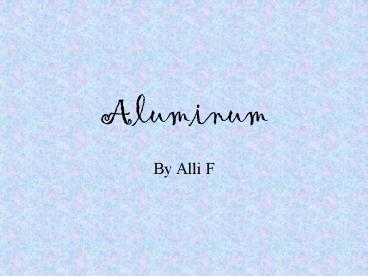Aluminum - PowerPoint PPT Presentation
1 / 10
Title:
Aluminum
Description:
Hans Christian Oersted obtains a highly impure sample of aluminium, by the ... Henri Sainte-Claire Deville devises a low cost method of producing sodium and ... – PowerPoint PPT presentation
Number of Views:1269
Avg rating:3.0/5.0
Title: Aluminum
1
Aluminum
- By Alli F
2
The History of Aluminum
1825Hans Christian Oersted obtains a highly
impure sample of aluminium, by the action of
potassium on aluminium chloride. 1854Henri
Sainte-Claire Deville devises a low cost method
of producing sodium and substitutes its use for
potassium in the manufacture of aluminium.
1886Paul L.V. Heroult and Charles Martin Hall
independantly develop an electrolytic method for
producing aluminium.They obtain patents in
France and the US respectively, based on the
electrolysis of aluminium dissolved in fused
aluminium fluoride.
3
Orbitals of Aluminum
4
Aluminums most common state is solid
5
- Pure Aluminum is a silvery-white metal. It is
light and nontoxic (as the metal). - It is nonmagnetic, with a dull shine.
- It is somewhat decorative, and used in many
household products. - It is easily formed, machined, and cast.
6
Aluminum as a solid
7
Properties of Aluminum
- Pure Aluminum is soft and lacks strength.
- alloys with small amounts of copper, magnesium,
silicon, manganese, and other elements have very
useful properties.
8
Finding Aluminum
- Aluminum is an abundant element in the earth's
crust, but it is not found free in nature. - The Bayer process is used to refine Aluminum
from bauxite, an Aluminum ore.
9
Aluminum stats
- Aluminum has 13 electrons
- Aluminum has only one known isotope
- it melts at a temperature of 933.57 K
- it boils at a temperature of 2740 K
10
Bibliography
- Sites used include
- Elementistory.com
- Webelements.com
- Chemicool periodic table































